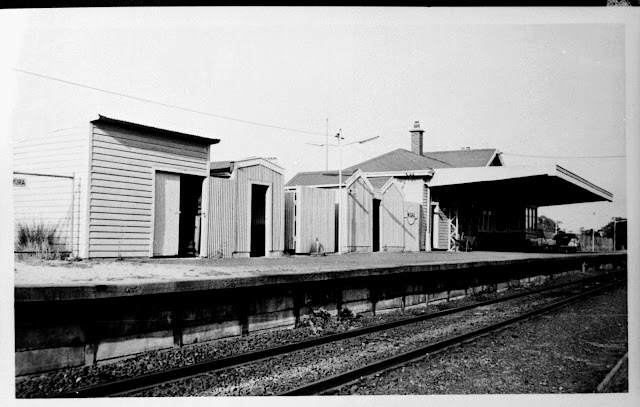Nyora is not actually on the Koo Wee Rup Swamp, but it is near enough and was actually just the fourth stop down from Koo Wee Rup on the Great Southern Railway line - the stations went - Koo Wee Rup, Monomeith, Caldermeade, Lang Lang and then Nyora. In common with Koo Wee Rup it was also a railway junction. Koo Wee Rup was the starting point for the Strzelecki line which opened officially June 29, 1922 and Nyora was the starting point for the Wonthaggi line.
The first land sales in the township, which by then was named named Nyora, were held on September 6, 1887 (2). Nyora, is from the Aboriginal word for “wild cherry tree”(3).
The first school in the area was State School No. 2523, originally called Little Lang Lang. It opened on July 1, 1883 in a building 22ft by 13ft.; it was replaced by a larger building in 1889 and changed its name to Lang Lang East in February 1890. It closed October 1903, reopened November 1904 and closed again in June 1907 (or 1908 according to one source). This school was north of the township, on a corner of Allotment 61 on the Lang Lang East Parish Plan (see map, below). I can’t work out where it is on a modern map as none of the maps seem to have a road marked anywhere close to where the school was! The building was removed in 1914 (8).
This is from the Parish Plan of Lang Lang East - the township of Nyora can be seen bottom left. The original school on Lot 61on Charles Humphries land, is circled in red. It was no wonder that the people on Nyora wanted a new school built in the town, it was a long way away.
There was agitation as early as 1890 for a school closer to the town, and from 1894 until 1901 many parents sent their children on the train from Nyora to the Lang Lang School. For a while the School was conducted in the Public Hall but finally on May 1, 1903 Nyora School, No. 3401 was opened (9).
The Nyora Hall commenced construction in 1891 and was completed by the April of the next year. This hall is thought to have burnt down in the 1898 bush fires and the new Hall was opened in March 1900, on a new site (which is the site of the existing hall). This Hall was extended over the years to include a Library and other rooms. Sadly this well used hall was destroyed by fire on January 20, 1968. The Community worked hard to raise funds for the new hall which was opened on December 6, 1974 (10).
Footnotes(1) White, Joseph Nyora: its yesterdays and today (Nyora and District Centenary Year Celebrations, 1978), p. 1.
(2) White, op. cit.,p.1
(3) Ibid
(4) Bowden, Keith Macrae Great Southern Railway: the illustrated history of the building of the line in South Gippsland (Australian Railway Historical Association, 1970), p. 72.
(5) White, op. cit.
(7) Harrigan, Leo. J Victorian Railways to '62 (Victorian Railways, 1962), p. 287
(8) White, op. cit., pp. 6 & 7. Also - Vision and Realisation : a centenary history of State Education in Victoria, edited by L.J. Blake. Published by the Education Department of Victoria, 1973.
(9) White, op. cit., pp. 21 & 22.
(10) White, op. cit., pp 22-24.






No comments:
Post a Comment